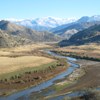Research Activities
Geomorphology and palaeoenvironmental studies

Geomorphology comprises the study of landforms and earth surface processes. Palaeoenvironmental studies aim at reconstructing these former geomorphologic processes and at inferring past environmental conditions from them. This knowledge of past interactions between climate, geomorphic processes and human impact is essential for developing future scenarios of global change.
Our group is particularly interested in reconstructing palaeoenvironments of the Quaternary. This youngest period of the earth’s history is characterized by strong climatic variability. Legacy of these climatic fluctuations are glacial deposits, fluvial terraces, dunes and loess-palaeosol sequences. We use these geo-archives in different regions of the world in order to reconstruct the variable environmental conditions of the Quaternary.
Historical soil erosion

Soil erosion is a global phenomenon and is a great risk to our society, as it destroys soils and therefore, our livelihood. The process of soil erosion proceeds gradually over relatively long periods, therefore it is often not perceived as instantaneous natural hazard. The process is thus often termed as creeping disaster.
Soil erosion is not only a problem of our modern, industrialized society, but already commenced in the Neolithic, when farming became the livelihood of the Neolithic cultures. Farming leads to a destruction of soil protecting vegetation, which in term leads to excessive soil erosion. In central Europe, this process started around 5.500 BCE, in the Middle East already around 8000 BCE. Several periods since the Neolithic are known to be contemporaneous with phases of massive soil erosion, such as the Roman period and the Middle Ages.
Reconstruction of soil erosion provides information on the complex interactions between humans and the environment. Under consideration of natural (e.g. climate) and anthropogenic (e.g. subsistence strategies) factors, our group focuses on causes and impact of soil erosion. The reconstruction is based on the study of colluvial and alluvial deposits on slope toes and floodplains, in particular their chronology and accumulation rates.
Geoarchaeology

Geoarchaeology investigates past interaction of humans with the environment, thus aims at solving questions about our cultural history using geoscientific methods. Which environmental conditions were encountered by ancient cultures, where did settlements get their water from, and which soil types formed the base for farming? Geomorphology plays a very important role in answering these exemplary questions, by investigating the availability of natural resources and their change through space and time. As a result, geoarchaeology analyses the impact of changing environments on ancient cultures, as well as human impact on the landscape. Our group uses sedimentary archives and their (geo-)archaeological inventory as well as their chronology for understanding past landscapes and environmental conditions during times of human occupation.
Luminescence dating

A reliable chronology plays an important role in geomorphology and palaeoenvironmental studies. Chronologies are crucial for quantifying geomorphic processes and for investigating the timing and frequencies of palaeoenvironmental change. Luminescence dating is considered a very important dating technique for this research field, as it directly dates the event of sedimentation. Luminescence dating offers broad application to all sorts of sediments, covering aeolian, fluvial, glaciofluvial and colluvial deposits, as well as archaeological ceramics. Our group is specialised on the application as well as the methodological development of this dating technique. We use state-of-the-art technology and work in close co-operation with the maufacturers of our measurement devices.
R-package 'Luminescence'
